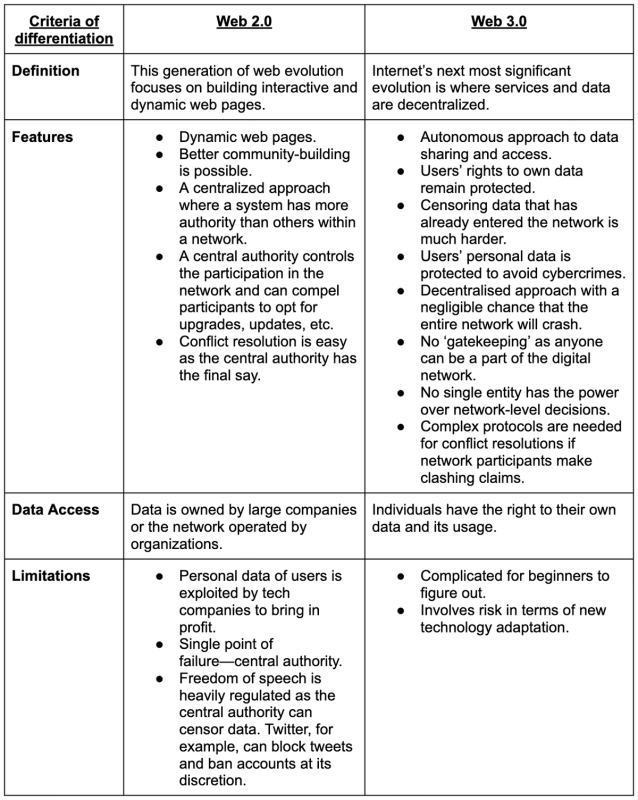
Differences between Web 2.0 and Web 3.0
This article highlights the features, benefits, and limitations of Web 2.0 and Web 3.0 and their differences.

The web world has undergone significant changes in the past few decades. The hype surrounding blockchain technology has naturally led to the rise in curiosity about Web 3.0. In this article, we see how the Web has evolved since its inception, the new revolutionary idea that is Web3.0, and the differences between Web 2.0 and Web 3.0.
Resources:
https://academy.eincode.com/courses/nft-marketplace-in-react-js-next-typescript-full-guide
Web 2.0 — Features and Benefits
Web 2.0 is the second phase of the internet's evolution. Web 2.0 provides us with websites capable of reading and taking in our information and a personalized experience. A prime example is the social networking sites that we use daily.
The introduction of Adobe Flash and programming languages such as Javascript made it easier for developers to build user-friendly applications. Examples of such web pages include video posting sites like Youtube, blogging sites such as WordPress, and social networking sites like Facebook, Twitter, and Instagram.
Web 2.0 has introduced us to a new wave of connectivity, and its features help users create content and publish it to a broader audience. Apart from user-generated content, some of the other noteworthy features of Web 2.0 include -
- Ease of use and knowledge sharing.
- The ability to produce and publish dynamic content.
- Real-time interaction.
- The ability to use web APIs of popular applications to develop our application has increased interactivity.
Web 2.0 Limitations
The era of Web 2.0 is the time for hyper-targeted advertising. Major Web 2.0 limitations include exploiting personal data by large companies to provide personalized ads.
These second-generation websites also harbor many security issues that lead to cyber-attacks and instances of hacking. Attacks of such malicious nature cause a leak in users' personal information. This furthers the need for a more decentralized approach to handling sensitive information.
Yet another limitation of Web 2.0 is that third-party applications moderate communication between two ends. This is evident in the case of payment gateways, for example. Payment applications have the power and control to disapprove certain transactions at their discretion.
What is Web 3.0?
Web 3.0 is the next stage of web evolution that leverages blockchain technology and a decentralization approach. The applications built using this are called decentralized apps or DApps. They use Ethereum's decentralization approach to store, share, and access data.
Notable Web 3.0 applications that the world has recently seen are Apple Siri, Wolfram Alpha, video sites like Odysee, etc. Since Web 3.0 is in its early stages of adoption, applications in this area are primarily work-in-progress.
Features and Benefits of Web 3.0
Web 3.0 services come with their own set of features and benefits that efficiently overcome the limitations of the previous iterations of the Web. One of the main features of Web 3.0 applications is that data is not under the control of any private or government organization. Hence the data stored cannot be changed or deleted by anyone or organization without proper access.
As stated, permission to use services and data are equally granted to all on the network, and a single entity can't lay a claim on it. This also ensures that no one can be denied access to data on the network. And data deleted from a machine on the network doesn't guarantee its removal from all devices on the network.
Lastly, data on Web 3.0 is not limited to a single server but is shared across the entire blockchain network. This means a server failure or shutdown doesn't affect Web 3.0 services or data access. Payment applications operating on Web 3.0 also operate independently without accessing the user's personal information, thus furthering anonymity.
Drawbacks of Web3
Here are a few limitations of Web 3.0 that need attention -
Skills
Developing Web 3.0 applications require specialized knowledge of how the blockchain operates. Developers will need to navigate this obstacle to build and adapt applications specifically for Web 3.0. But we now understand that it's worth it.
Delayed transactions
Being a distributed system becomes challenging when transactional activities turn out to be time-consuming. Different stages of payment, for example, will need to be processed by other nodes in the network, which make the approach cumbersome.
Tougher to regulate
Web 3.0 applications can bring a whole bout of regulation issues for organizations. We will need smarter solutions to these problems to avoid cybercrimes.
Web 2.0 vs Web 3.0

Conclusion
The changes that Web3.0 will bring to our lives may be slow but worth it. This evolution will more likely be a succussion of autonomous ideas put together. It is also likely that more decentralized organizations or DAOs will emerge to replace existing large corporations.
The most exciting fact about Web 3.0 is the novelty of the idea surrounding it. With suitable systems and protocols in place, Web 3.0 can undoubtedly become the new standard in the future. Furthermore, existing tech companies like Google or Facebook may resort to a disassembled approach to stay relevant in the competitive market.
Here's a great resource if you want to ride the wave, get past the theoretical fundamentals, and dive deep into blockchain development. The course will teach you how to create DApps and Smart contracts in Solidity, full applications in React and Next JS, and how the Ethereum blockchain works.

Filip Jerga
Senior developer and educator passionate about making programming accessible to everyone through practical, hands-on learning experiences. Creator of 100+ courses with over 100,000 students worldwide.
Enjoyed this article?
Subscribe to our newsletter to get the latest programming tutorials and insights delivered directly to your inbox